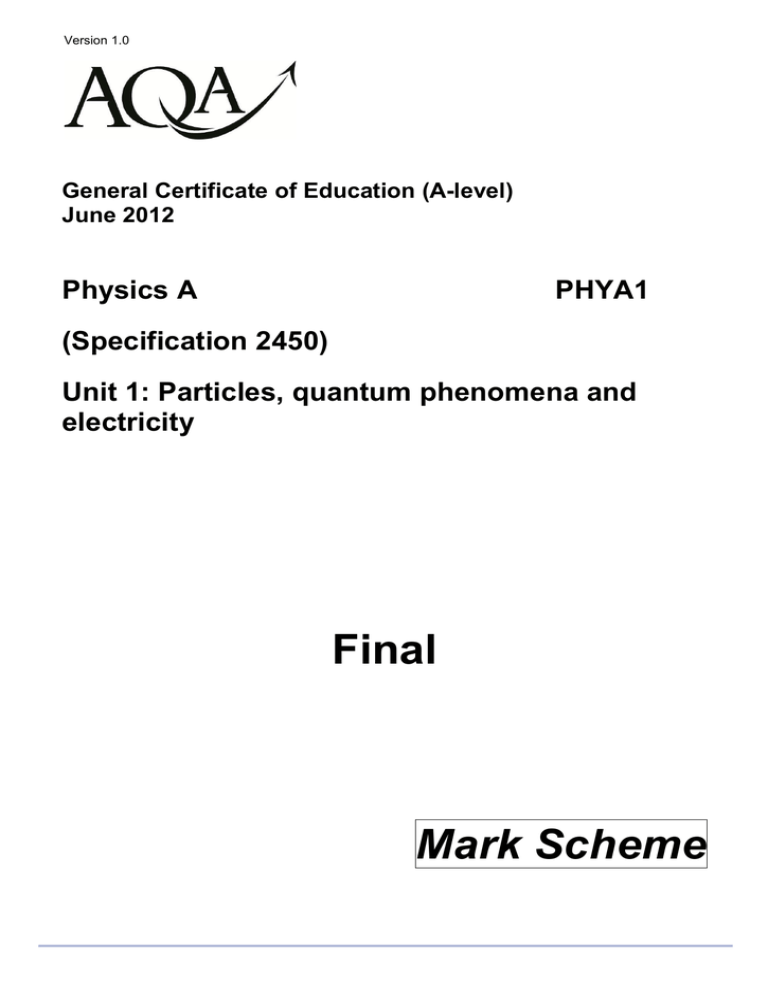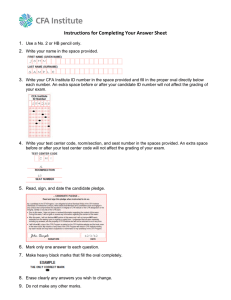
Version 1.0
General Certificate of Education (A-level)
June 2012
Physics A
PHYA1
(Specification 2450)
Unit 1: Particles, quantum phenomena and
electricity
Final
Mark Scheme
Mark schemes are prepared by the Principal Examiner and considered, together with the relevant
questions, by a panel of subject teachers. This mark scheme includes any amendments made at the
standardisation events which all examiners participate in and is the scheme which was used by them
in this examination. The standardisation process ensures that the mark scheme covers the
candidates’ responses to questions and that every examiner understands and applies it in the same
correct way. As preparation for standardisation each examiner analyses a number of candidates’
scripts: alternative answers not already covered by the mark scheme are discussed and legislated for.
If, after the standardisation process, examiners encounter unusual answers which have not been
raised they are required to refer these to the Principal Examiner.
It must be stressed that a mark scheme is a working document, in many cases further developed and
expanded on the basis of candidates’ reactions to a particular paper. Assumptions about future mark
schemes on the basis of one year’s document should be avoided; whilst the guiding principles of
assessment remain constant, details will change, depending on the content of a particular examination
paper.
Further copies of this Mark Scheme are available from: aqa.org.uk
Copyright © 2012 AQA and its licensors. All rights reserved.
Copyright
AQA retains the copyright on all its publications. However, registered centres for AQA are permitted to copy material from this
booklet for their own internal use, with the following important exception: AQA cannot give permission to centres to photocopy
any material that is acknowledged to a third party even for internal use within the centre.
Set and published by the Assessment and Qualifications Alliance.
The Assessment and Qualifications Alliance (AQA) is a company limited by guarantee registered in England and Wales (company number 3644723) and a registered
charity (registered charity number 1073334).
Registered address: AQA, Devas Street, Manchester M15 6EX.
Mark Scheme – General Certificate of Education (A-level) Physics A – PHYA1 – June 2012
Instructions to Examiners
1
Give due credit for alternative treatments which are correct. Give marks for what is correct in
accordance with the mark scheme; do not deduct marks because the attempt falls short of
some ideal answer. Where marks are to be deducted for particular errors, specific instructions
are given in the marking scheme.
2
Do not deduct marks for poor written communication. Refer the scripts to the Awards meeting
if poor presentation forbids a proper assessment. In each paper, candidates are assessed on
their quality of written communication (QWC) in designated questions (or part-questions) that
require explanations or descriptions. The criteria for the award of marks on each such
question are set out in the mark scheme in three bands in the following format. The descriptor
for each band sets out the expected level of the quality of written communication of physics for
each band. Such quality covers the scope (eg relevance, correctness), sequence and
presentation of the answer. Amplification of the level of physics expected in a good answer is
set out in the last row of the table. To arrive at the mark for a candidate, their work should first
be assessed holistically (ie in terms of scope, sequence and presentation) to determine which
band is appropriate then in terms of the degree to which the candidate’s work meets the
expected level for the band.
QWC
descriptor
mark range
Good - Excellent
see specific mark scheme
5-6
Modest - Adequate
see specific mark scheme
3-4
Poor - Limited
see specific mark scheme
1-2
The description and/or explanation expected in a good answer should include a
coherent account of the following points:
see specific mark scheme
Answers given as bullet points should be considered in the above terms. Such answers
without an ‘overview’ paragraph in the answer would be unlikely to score in the top band.
3
An arithmetical error in an answer will cause the candidate to lose one mark and should be
annotated AE if possible. The candidate’s incorrect value should be carried through all
subsequent calculations for the question and, if there are no subsequent errors, the candidate
can score all remaining marks.
4
The use of significant figures is tested once on each paper in a designated question or partquestion. The numerical answer on the designated question should be given to the same
number of significant figures as there are in the data given in the question or to one more than
this number. All other numerical answers should not be considered in terms of significant
figures.
5
Numerical answers presented in non-standard form are undesirable but should not be
penalised. Arithmetical errors by candidates resulting from use of non-standard form in a
candidate’s working should be penalised as in point 3 above. Incorrect numerical prefixes and
the use of a given diameter in a geometrical formula as the radius should be treated as
arithmetical errors.
6
Knowledge of units is tested on designated questions or parts of questions in each a paper.
On each such question or part-question, unless otherwise stated in the mark scheme, the
mark scheme will show a mark to be awarded for the numerical value of the answer and a
further mark for the correct unit. No penalties are imposed for incorrect or omitted units at
intermediate stages in a calculation or at the final stage of a non-designated ‘unit’ question.
7
All other procedures including recording of marks and dealing with missing parts of answers
will be clarified in the standardising procedures.
3
Mark Scheme – General Certificate of Education (A-level) Physics A – PHYA1 – June 2012
GCE Physics, Specification A, PHYA1, Particles, Quantum Phenomena and Electricity
1
a
i
quark antiquark pair OR qq OR named quark antiquark
pair
1
1
a
ii
0
1
1
a
iii
us
1
1
b
i
Weak any of the following also score 1 mark:
weak interaction
weak interaction force
weak nuclear
weak nuclear interaction
weak decay
weak force
weak nuclear force
1
1
b
ii
conserved: baryon number, charge, lepton number, spin
3
not conserved: strangeness
1
b
iii
K 0 e v(e)
OR
2
a
i
2
K 0 v( )
nucleon number is the number of protons and neutrons
OR mass number
proton number is the number of protons OR atomic
number
1
1
2
a
ii
14 – 6 =8
2
a
iii
specific charge =6 × 1.6 × 10
–19
/(14×1.66×10
–27
)
–1
7
specific charge = 4.1 × 10 (C kg )
2
b
i
isotopes are variations of an element that have same
proton/atomic number
but different nucleon number OR different number of
neutrons
2
b
ii
7
4.8 × 10 = 6 × 1.6 × 10
A = 6 × 1.6 × 10
–19
–19
/(A × 1.66 × 10
2
–27
)
–27
7
/(4.8 × 10 × 1.66 × 10
A = 12
Number of neutrons = 12-6
3
3
)
3
a
interaction
exchange particle
weak
W OR W OR Z°
electromagnetic
photon OR
+
4
-
2
Mark Scheme – General Certificate of Education (A-level) Physics A – PHYA1 – June 2012
3
b
3
c
uud
i
1
an atomic/orbital/shell electron
interacts with a proton in the nucleus (via the weak
interaction)
3
neutron formed or u quark changes to d quark(and
neutrino released)
3
c
ii
(e)
n(d)
W
p(u)
4
a
i
3
+
e
-
minimum energy required
to remove electron from metal (surface) OR cadmium OR
the material
4
a
ii
2
photons have energy dependent on frequency OR energy
of photons constant
one to one interaction between photon and electron
Max KE = photon energy – work function in words or
symbols
4
more energy required to remove deeper electrons
4
a
iii
(use of hf=+Ek(max))
–34
6.63 × 10
× f = 4.07 × 1.60 × 10
f = 1.04 × 10
4
5
b
a
15
(Hz) OR 1.03 × 10
–19
15
+ 3.51 × 10
–20
4
(Hz) (3 sig figs)
theory makes predictions tested by repeatable/checked
by other scientists/peer reviewed (experiments) OR new
evidence that is repeatable/checked by other
scientists/peer reviewed
2
The candidate’s writing should be legible and the
spelling, punctuation and grammar should be
sufficiently accurate for the meaning to be clear.
The candidate’s answer will be assessed holistically. The
answer will be assigned to one of three levels according
to the following criteria.
High Level (Good to excellent): 5 or 6 marks
The information conveyed by the answer is clearly
organised, logical and coherent, using appropriate
specialist vocabulary correctly. The form and style of
writing is appropriate to answer the question.
The candidate states that the power supply is connected
5
max 6
Mark Scheme – General Certificate of Education (A-level) Physics A – PHYA1 – June 2012
to the input of the oscilloscope. The time base is switched
off and the y gain adjusted until a complete vertical line is
seen on the screen. The length of the line is measured
and this is converted to peak to peak voltage using the
calibration. The peak voltage is divided by root two to get
the rms voltage and this is compared with the stated
value. The time base is now switched on and adjusted
until a minimum of one cycle is seen on the screen. The
length of one cycle is measured and this is converted to
time using the time base setting. Frequency is the
reciprocal of this time.
Intermediate Level (Modest to adequate): 3 or 4 marks
The information conveyed by the answer may be less well
organised and not fully coherent. There is less use of
specialist vocabulary, or specialist vocabulary may be
used incorrectly. The form and style of writing is less
appropriate.
The candidate states that the power supply is connected
to the input of the oscilloscope. The y gain adjusted. The
length of the line/height of peak is measured. The peak
voltage is divided by root two to get the rms voltage. The
time base is now switched on and adjusted until a
minimum of one cycle is seen on the screen. The length
of one cycle is measured and this is converted to time
using the time base setting.
Low Level (Poor to limited): 1 or 2 marks
The information conveyed by the answer is poorly
organised and may not be relevant or coherent. There is
little correct use of specialist vocabulary. The form and
style of writing may be only partly appropriate.
The candidate states that the power supply is connected
to the input of the oscilloscope. The length of the
line/height of peak is measured. The time base is now
switched on and adjusted until a minimum of one cycle is
seen on the screen. The length of one cycle is measured
and this is converted to time.
The explanation expected in a competent answer
should include a coherent selection of the following
points concerning the physical principles involved
and their consequences in this case.
5
b
i
power supply connected to oscilloscope input
time base initially switched off
y gain adjusted to get as long a line as possible
length of line used to find peak to peak voltage
rms voltage found
time base switched on and adjusted to get several
cycles on the screen
use the time base setting to find period
use period to find frequency
compare vales with stated values
(use of P = IV)
I = 24/12 = 2.0 (A)
6
1
Mark Scheme – General Certificate of Education (A-level) Physics A – PHYA1 – June 2012
5
b
ii
peak current = 2 × 2.0 = 2.8 (A)
1
5
b
iii
peak power = 2 × 12 × 2 × 2.0 = 48 (W)
2
6
a
i
(use of P=VI)
I = 36/12 + 6/12 = 3.5 (A)
6
a
ii
(use of V=IR)
R = 12/3 =4 (Ω)
6
a
6
b
iii
R = 12/0.50 = 24 (Ω)
2
1
1
terminal pd/voltage across lamp is now less OR current is
less
due to lost volts across internal resistance OR due to
higher resistance
3
lamps less bright
6
c
i
current through lamps is reduced as resistance is
increased or pd across lamps is reduced as voltage is
shared
2
hence power is less OR lamps dimmer
6
c
ii
lamp Q is brighter
lamp Q has the higher resistance hence pd/voltage
across is greater
max 3
current is the same for both
hence power of Q greater
7
a
i
(use of V = IR)
I = (12-8) /60 = 0.067 Or 0.066(A)
7
a
ii
(use of V = IR)
R = 8/0.067 = 120 (Ω)
7
a
iii
(use of Q = It)
Q = 0.067 × 120 = 8.0 C
7
b
2
1
2
reading will increase
resistance (of thermistor) decreases (as temperature
increases)
current in circuit increase (so pd across R1 increases) OR
correct potential divider argument
UMS conversion calculator www.aqa.org.uk/umsconversion
7
3




